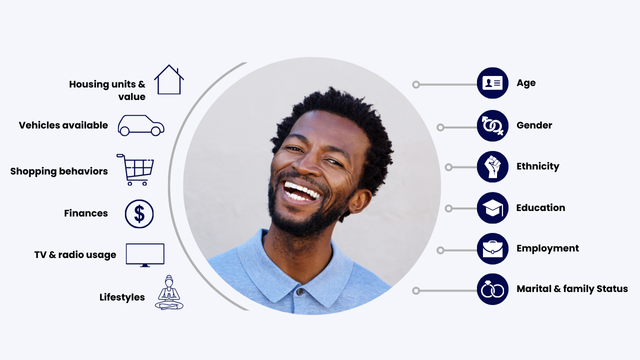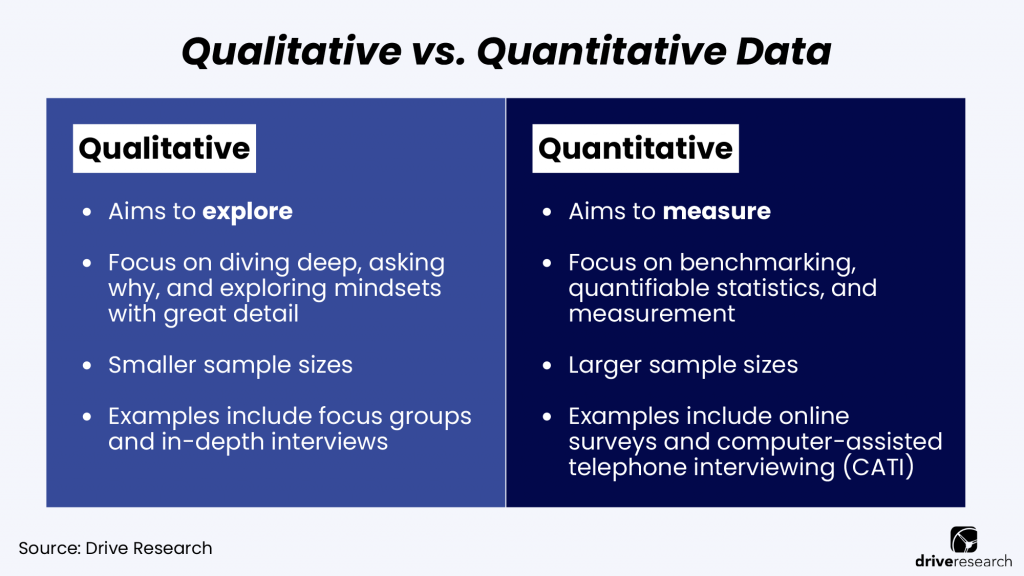
In today’s fast-paced business landscape, understanding the needs, preferences, and expectations of customers is paramount for success.
This is where Voice of Customer (VoC) market research emerges as a pivotal tool.
By tapping into the authentic voices of consumers, VoC research provides invaluable insights that shape strategies, drive innovation, and foster customer-centric approaches.
In this blog post, our market research company will share the what, how, and why of voice of customer research. Plus, we’ll share the details of a client project Drive Research completed with a manufacturing company.
Defining Voice Of The Customer
The Voice of the Customer (VoC) refers to the process of capturing, understanding, and analyzing the opinions, preferences, needs, and expectations of customers regarding a product, service, or brand.
It involves gathering feedback directly from customers through various channels such as surveys, interviews, social media, reviews, and direct interactions.
That’s why Voice of Customer is commonly a formal market research process structured to ask questions, collect feedback, tabulate results, and take action based on customer data.
The program is designed to learn more from customers, including their profile, needs, wants, and drivers to loyalty. Ultimately, VoC is a form of market research designed to better connect with customers.
Value of Voice of Customer for Businesses
There are several reasons as to why VoC is important to a business or organization. Voice of Customer research lays the foundation for strategy.
It is often used as a first step before a marketing plan is designed or a new strategy is implemented. Market research “quantifies the gut feeling.”
Management may have gut feelings of who their customers are or why they act but without real data from customers, you can never be 100% sure.
VoC supports the theory that whoever knows the customer best wins.
In a competitive landscape, understanding the customer is crucial. It makes sure the feedback you receive from customers that explains their wants and needs can be integrated into strategy and decisions.
Voice of Customer studies ensure your decisions at a business are aligned with the needs of a customer. It’s obtaining feedback from those who matter most.
At the end of the day, market research eliminates risk.
The Benefits of Voice of Customer (VoC)
Several benefits exist when an organization works with a VoC company.
1. Customer Profiling
The first is profiling and segmentation. Not all customers purchase a product or service for the same reason.
Collecting VoC helps you understand the demographics and behaviors of your 3 types of best customers, 5 types, or 12 types.
Understanding why customers buy, what makes them loyal, and why they choose your organization over other companies is critical data. VoC market research gives you an inside look into the mind of your customers.

2. Guide Budgets
Another benefit is using VoC to guide your budget. What if you knew how many of your customers were on LinkedIn, Facebook, Twitter. Or, how many watch TV, use Google search, listen to the radio, etc.
It becomes much easier to dice up your marketing dollars accordingly.
3. Build Content
An emerging benefit of VoC is to build content. Many organizations conduct industry surveys and decide to share the results in infographics and other press releases to share nuggets of information with news outlets.
This type of content can position your brand as a thought-leader in the space.
4. Measure Key Performance Indicators (KPIs)
The last benefit is KPIs. Google Analytics and big data do a great job of explaining the “what” of the data.
VoC surveys or focus groups are an excellent way to provide depth around the “why”. It provides additional detail and context for your marketing campaigns.
Voice of Customer studies can measure awareness, perceptions, likelihood to purchase, and many other key performance indicators.
Types of Voice of Customer (VoC)
Types of VoC include both qualitative and quantitative market research. Qualitative market research is aimed at exploring while quantitative is aimed at measurement.
While the two most common forms of VoC are surveys (quantitative) and focus groups (qualitative), there are other methodologies available to measure customer experiences.

Common forms of Voice of Customer market research include:
1. Online Surveys
Online surveys are structured questionnaires designed to gather specific feedback from a large number of customers.
They typically include closed-ended questions with predefined response options, allowing for easy data analysis and quantification of customer opinions, preferences, and satisfaction levels.
2. Focus Groups
Focus groups involve small groups of customers who participate in guided discussions or activities facilitated by a moderator. This qualitative research method allows for in-depth exploration of customer perceptions, attitudes, and behaviors.
Focus groups provide rich, nuanced insights into customer motivations and preferences, helping businesses understand the “why” behind certain opinions or trends.
3. User Experience (UX) Research
UX research focuses on understanding how customers interact with a product or service and their overall experience throughout the user journey.
This type of research often involves usability testing, interviews, and observations to identify pain points, usability issues, and opportunities for improvement in the user interface, design, and functionality.
4. Intercept Surveys
Intercept surveys are conducted in real-time, usually at the point of interaction between the customer and the business, such as in-store or on a website.
These surveys capture immediate feedback from customers about their experience, satisfaction levels, and any issues encountered.
Intercept surveys are valuable for capturing spontaneous reactions and addressing concerns promptly.
5. Mystery Shopping
Mystery shopping involves hiring individuals (mystery shoppers) to pose as regular customers and evaluate the quality of service, product offerings, and overall customer experience.
Mystery shoppers follow predefined scenarios and criteria to assess various aspects of the customer journey, providing businesses with unbiased insights into the performance of their frontline staff and operations.
6. In-Home Usage Tests
In-home usage tests (IHUTs) involve providing customers with a product to use in their own homes over a specified period.
Customers then provide feedback on their experience, usage patterns, likes, dislikes, and any issues encountered.
IHUTs offer a realistic environment for assessing product performance and acceptance, particularly for consumer goods and household products.
7. Geofencing Survey
Geofencing surveys use location-based technology to target customers within a specific geographic area, such as a retail store or event venue.
When customers enter the designated area, they may receive prompts to participate in a survey or provide feedback via mobile apps or other digital platforms.
Geofencing surveys enable businesses to gather insights from customers in real-world contexts and tailor feedback requests based on their proximity to certain locations.
How Does the VoC Process Work?
The process at our VoC market research company follows a step-by-step process. It all starts with a proposal document which highlights the objectives, approach, timeline, fees, and deliverables.
The VoC process moves from kickoff to workplan, design, fieldwork, and then reporting.
The final report includes an executive summary with themes, recommendations, an infographic, customer persona, and an appendix of question-by-question results.
Should Voice of Customer (VoC) Be Conducted In-House?
The largest benefit of conducting VoC in-house is the perceived cost savings. I say perceived because it will always take someone with less experience and skills longer to design a survey or write a report than an experienced market research consultant.
So what is the actual trade-off of time and cost?
The largest con of conducting the VoC in-house is bias. Your customers will likely not give you an honest opinion.
It’s what we deem the “messy roommate bias“. If you are looking for accurate and reliable feedback, particularly negative feedback, customers want to talk to a third party.
The choice is a tough one. Perceived cost savings versus inaccurate or unreliable results.
Recommended Reading: Market Research – Is Inhouse or Outsourced Better?
Real-World Example of Voice of Customer Market Research
Recently, a manufacturing company hired Drive Research for a Voice of Customer (VoC) survey.
VoC surveys are great at identifying strengths and weaknesses, insights to improve customer satisfaction, and insights to make marketing/sales efforts more effective.
In this section, our VoC market research company outlines the objectives, approach, and results of this VoC survey for a manufacturing company.
VoC Survey Objectives
The VoC survey addressed several core objectives. This included understanding how much the manufacturing company has improved with customers since the 2017 VoC study with Drive Research, exploring other changes made in the last 2 to 3 years, and remeasuring key performance indicators (KPIs).
The survey also addressed other secondary objectives of the market research.
The survey gathered an honest perspective on these metrics through a third-party lens. The outcomes of the market research aided the client with operations, marketing, and strategy.
VoC Survey Approach & Results
To address the objectives at-hand, Drive Research recommended using an email survey to collect feedback.
These online surveys are far more cost-effective and timely than other methodologies such as a phone or physical mail survey. Most importantly, conducting an online VoC survey creates a strong ROI for our clients.
Fieldwork for the survey began on June 3 and lasted until June 26. The survey took an average of 6 minutes to complete and included 32 questions. The survey received 375 responses (2% response rate).
The reliability of this data is high. At the 95% confidence interval, the margin of error for these results is +/- 5%.
If the survey was conducted with another 375 random customers, results would yield within +5% or -5% of the totals 95 out of 100 times.
Check out these examples VoC survey questions!
VoC Survey Report
The VoC survey report included the background and methodology, an executive summary of themes with recommendations, an infographic, customer personas, and the next steps for market research.
The appendix included a detailed question-by-question breakdown of the results.
The key findings and recommendations answered the following questions:
- How satisfied are customers with the manufacturing company?
- What drives satisfaction with the manufacturing company?
- How has the manufacturing company changed?
- How satisfied are customers with the manufacturing company employees?
- What matters most when customers select a company?
- How could the manufacturing company make ordering easier?
- What are the top sources of awareness for the manufacturing company?
- What else could the manufacturing company provide customers?
Other Voice of Customer (VoC) Case Studies
Are you looking for VoC case studies from our market research company? Here are several which speak to VoC objectives, approaches, and reporting. Visit the following links below for more information.
- New York State Fair Intercept Surveys
- Data Analytics and Loss Prevention Industry Study
- Voice of Customer Survey with a Manufacturer
- Hays Airport Intercept Surveys
- Voice of Customer Study for Kris-Tech Wire
Contact Our Voice of Customer Company
Drive Research is a Voice of Customer (VoC) market research company. Our team has worked on a number of projects with clients across the country in a variety of industries.
Wondering if we can help your organization with your VoC market research? Contact us below.



